In the fast-moving world of healthcare, decisions must be made quickly, accurately, and confidently. Yet for many practices, the tools and data needed to make those decisions remain scattered across multiple systems. That’s where Microsoft Fabric and a modern approach to healthcare data management come in.
If you’re a physician, practice manager, or administrator looking to improve operations, patient care, or financial performance, here are the key takeaways up front:
- Microsoft Fabric is an all-in-one platform for managing, analyzing, and acting on your data.
- Real-time intelligence helps improve responsiveness to operational and clinical trends.
- Power BI—integrated within Microsoft Fabric—delivers flexible, custom reporting.
- Data ownership means less vendor dependence and more meaningful insights.
- Microsoft Fabric is scalable and cost-effective for practices of all sizes.
- AI tools and smart alerts are built to improve decision-making.
Let’s take a deeper look at how this technology fits into modern healthcare data management and why now is the time to consider implementing Microsoft Fabric in your organization.
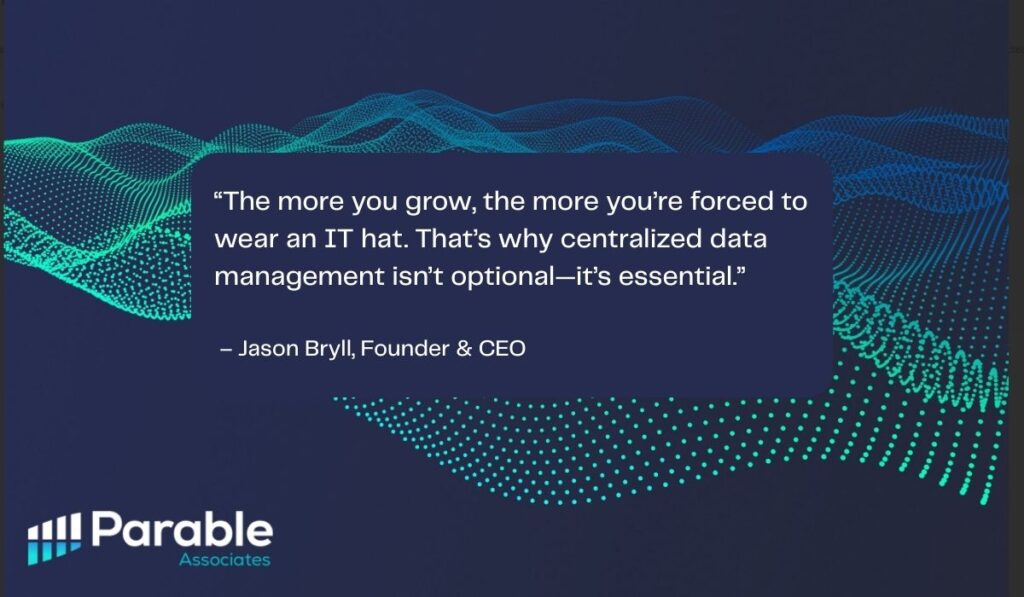
Demystifying Microsoft Fabric
Microsoft Fabric is not just another reporting tool—it’s a unified platform designed to simplify the entire data lifecycle, from ingestion to visualization. It brings together multiple services under one umbrella, including data engineering, data science, real-time analytics, and Power BI.
For practices struggling to connect systems like their EHR, billing software, HR platform, and call center data, Fabric offers a centralized solution for healthcare data management. Rather than maintaining multiple, disconnected tools and reports, Fabric consolidates them, improving efficiency and visibility across departments.
The Role of Data Factory in Integration
Fabric includes a powerful service called Data Factory, which supports ELT (Extract, Load, Transform) workflows. In healthcare data management, this means you can:
- Pull data from various systems (e.g., EHR, HRIS, clearinghouses)
- Load it into Microsoft’s cloud-based data architecture
- Transform and model it for unified, consistent reporting
Let’s say your billing system is running behind your Power BI report refresh schedule. Data Factory can trigger an automatic refresh as soon as the upstream data is available, removing manual work and ensuring data accuracy.
Even if you’re using platforms like Snowflake or Databricks, Microsoft Fabric can integrate via mirroring or data shortcuts, so you don’t need to move your data physically to work with it. That flexibility is a game-changer for healthcare organizations dealing with siloed data.
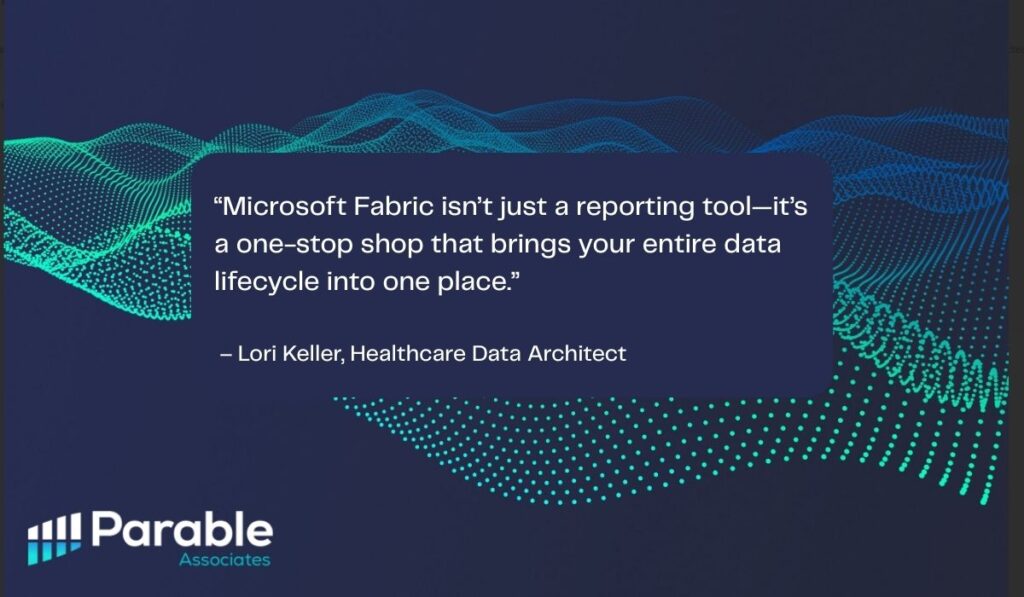
Unifying Disparate Systems
Many practices struggle with having multiple EMRs, different billing platforms, or custom scheduling templates. With Microsoft Fabric, all of these data sources can be brought together into one centralized location for analysis.
For example, imagine you use two different EMRs across locations. Fabric provides the tools and means of gathering your data into a unified data of reporting tables, like a standardized A/R table with key fields such as outstanding balances, aging buckets, and payer mix. That’s healthcare data management in action—simplifying complexity and making insights available to decision-makers.
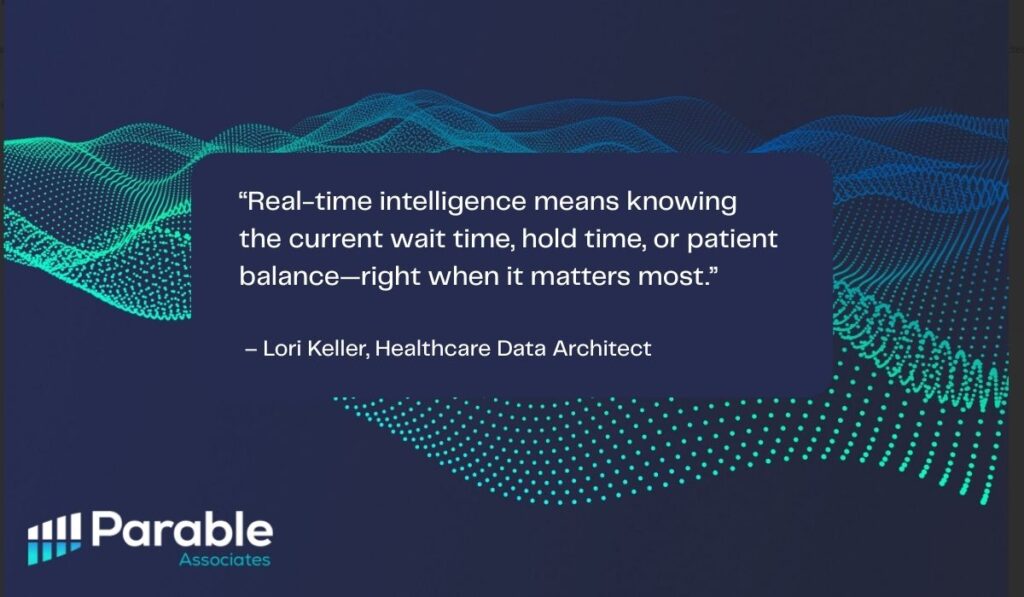
Real-Time Intelligence That Drives Impact
Modern healthcare organizations can’t afford to wait days or weeks for reports. That’s where real-time intelligence comes in—enabled by Fabric’s Event Stream capabilities.
Let’s say you’re a clinic manager who needs to know:
- How many patients are in the waiting room right now
- The average hold time at your call center
- Whether a patient with an outstanding balance is currently on-site
With Fabric, you can see those KPIs live and act on them immediately. In healthcare data management, timely access to data means the difference between reactive and proactive operations.
Tools like Data Activator—exclusive to Microsoft Fabric—allow you to set thresholds on key metrics and trigger alerts when those metrics change. You can be notified via Teams or email when patient collections drop, when A/R over 90 days spikes, or when wait times exceed target thresholds. In a recent blog, Microsoft announced that Data Activator alerts can be used to trigger actions in your data pipelines as well as retry pipeline actions when there are failures. These features empower leaders to stay in control of fast-moving environments.
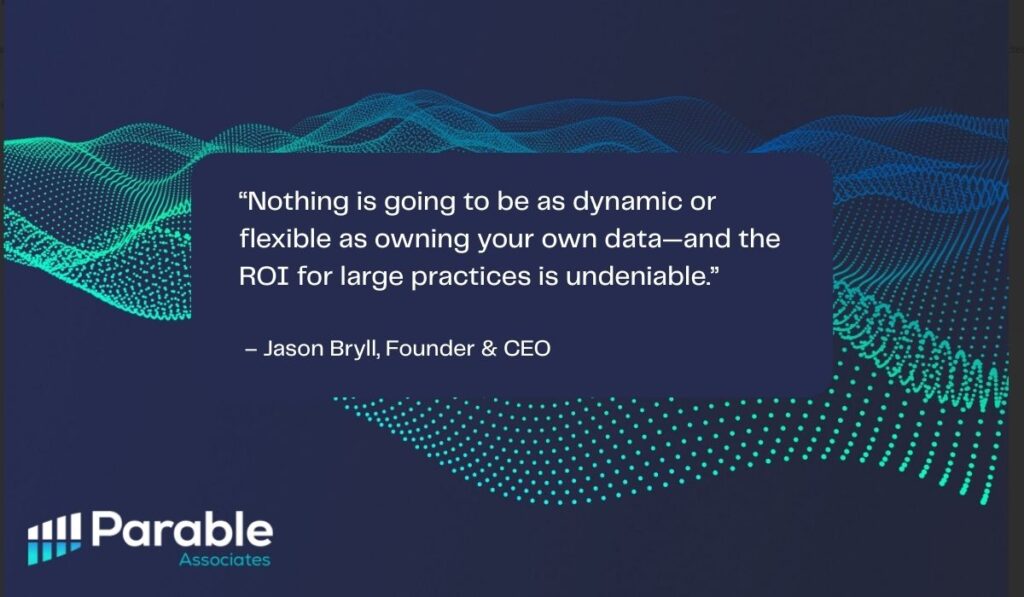
The Importance of Data Ownership
Every practice has its own workflows, definitions, and priorities. Off-the-shelf analytics tools often fall short because they apply general logic to highly specific operations.
With Microsoft Fabric, you maintain ownership of your data, which means:
- You define how metrics like denials, A/R, or patient volumes are calculated
- You control who has access to which reports and data
- You decide how reports are structured, shared, and consumed
This level of customization is critical in healthcare data management, where even simple metrics can vary widely depending on how your practice operates. Fabric ensures your reporting reflects your reality, not someone else’s template.
Power BI: The Reporting Engine Behind It All
Power BI is Fabric’s built-in analytics and visualization tool, and it’s one of the most widely used reporting platforms in the world. With Power BI, practices can build dashboards that are:
- Role-specific (e.g., front desk, billing, clinical, operations)
- Filtered for specific providers or locations
- Delivered via email, Teams, or embedded directly into PowerPoint or SharePoint
For example, your practice administrators can receive a dashboard every Monday morning summarizing key metrics like visits per provider, revenue per visit, and open balances by payer. Physicians can get snapshots of their own productivity or patient outcomes.
And with Power BI’s Smart Narrative and AI features, you can generate auto-summaries, detect outliers, or explore the “why” behind performance changes—all without writing a single line of code.
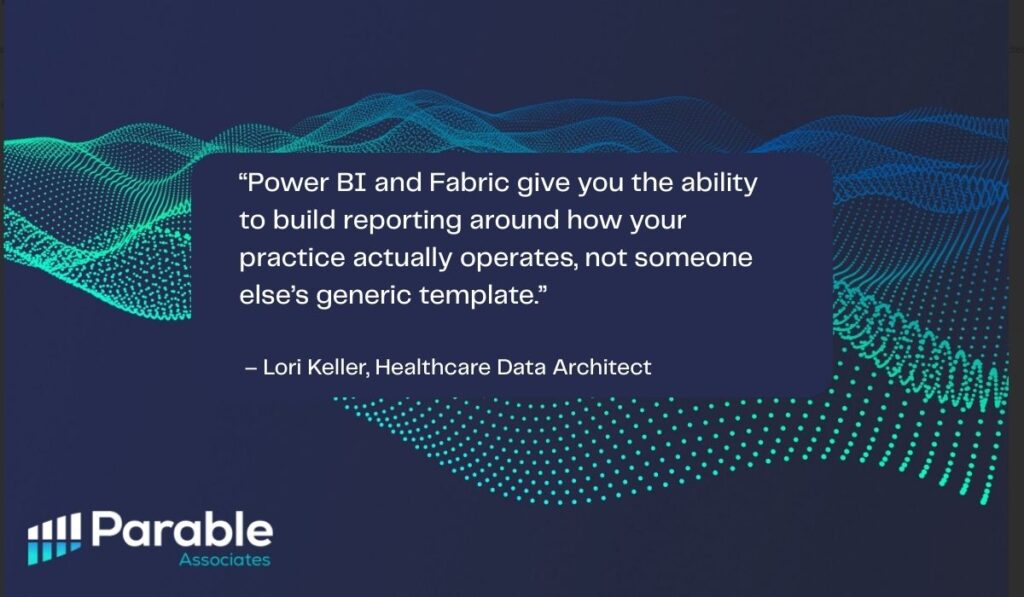
Practical Use Cases for Busy Healthcare Leaders
If you’re still wondering how Microsoft Fabric fits into your day-to-day responsibilities, here are a few concrete examples of its value in healthcare data management.
- Revenue Cycle Management: Unify data from clearinghouses, EMRs, and accounting systems to monitor A/R aging, denial trends, and payment posting delays.
- Workforce Analytics: Combine HR data with scheduling to analyze productivity, staff utilization, and overtime.
- Call Center Operations: Integrate call logs and EMR data to measure call resolution rates and link calls to patient outcomes.
- Patient Engagement: Use data from surveys, Google reviews, and marketing tools to track patient sentiment and outreach effectiveness.
Each of these areas benefits from a centralized data architecture, providing leaders with the real-time, cross-platform insights they need to make meaningful changes.
Built-In Scalability and Affordability
One of the concerns with enterprise-level tools is cost. Microsoft has addressed this with flexible pricing models. You can start with Power BI per user, and when you’re ready to scale, move into Fabric capacity with access to all of its integrated tools.
This makes Microsoft Fabric accessible for both smaller independent practices and large multi-specialty groups. You only pay for what you use, and as your data needs grow, Fabric scales along with your practice.
AI and the Future of Healthcare Data Management
Microsoft is heavily investing in AI across its platforms, and Fabric is no exception. With Copilot in Power BI, Smart Narrative summaries, and AI-powered sentiment analysis, users can now interact with data in natural language.
Want to know why appointment no-shows increased last month? Just ask.
Want to analyze patient feedback from reviews or surveys? Let Fabric extract themes and sentiments automatically.
AI is transforming healthcare data management by reducing the time it takes to turn information into action. With these features now available on lower-cost Fabric tiers, innovation is more accessible than ever before.
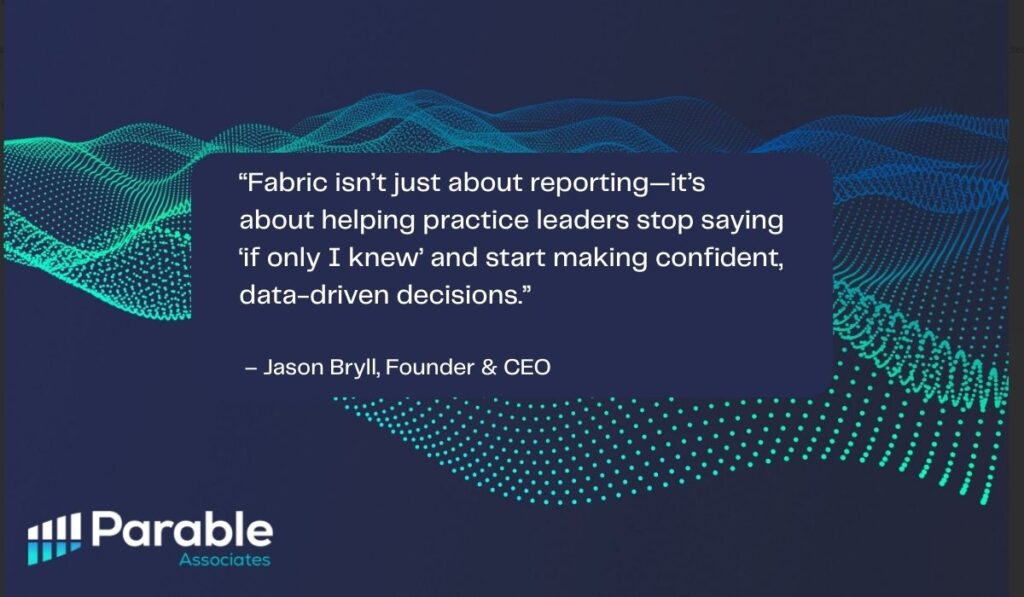
Take Control of Your Practice's Future
Running a healthcare practice already comes with enough challenges. You shouldn’t have to fight for your data or settle for limited insights. With Microsoft Fabric, you gain control over your reporting, your metrics, and ultimately, your business outcomes.
Here’s what to do next:
- Evaluate whether your current reporting gives you timely, actionable insights
- Audit whether your systems are connected or still siloed
- Ask your vendors about API access and data availability
- Consider whether owning your data would improve outcomes and decision-making
- Consult with a trusted partner, such as Parable Associates, to identify the best solution
The future of healthcare data management is proactive, connected, and intelligent—and Microsoft Fabric is helping lead that transformation.
Partner With Healthcare Business Intelligence Experts
Looking to explore how Microsoft Fabric could work for your practice? Let’s talk. At Parable Associates, we don’t just implement analytics platforms—we bridge the gap between complex healthcare data and real-world clinical and operational needs.
With decades of combined experience in healthcare operations, revenue cycle management, and practice administration, our team deeply understands the day-to-day challenges physicians and administrators face. We bring that firsthand knowledge to every engagement, ensuring your business intelligence solutions aren’t just technically sound—they’re tailored to the realities of running a medical practice.
From navigating siloed EHR systems to improving financial performance, optimizing staff workflows, and uncovering care gaps, we’ve helped healthcare organizations of all sizes extract more value from their data. Our team of healthcare-savvy data engineers, BI developers, and Power BI experts will work alongside your staff to build a modern data foundation that fuels strategic decisions, improves patient outcomes, and drives long-term growth.
Whether you’re ready to build a custom dashboard, streamline reporting across multiple locations, or launch a scalable Microsoft Fabric implementation, schedule a consultation and learn how our team can unlock the full potential of your healthcare data.
Healthcare Data Management with Microsoft Fabric FAQs
What is Microsoft Fabric, and how does it apply to healthcare practices?
Microsoft Fabric is a unified analytics platform that helps healthcare practices manage, analyze, and act on their data. It consolidates data from systems like EHRs, billing, HR, and patient feedback tools, enabling real-time insights and better decision-making.
How does Microsoft Fabric improve healthcare data management?
Fabric centralizes disparate data sources, supports real-time analytics, and empowers teams with tools like Power BI and Data Factory. This allows practices to monitor key metrics, optimize workflows, and act on trends faster than with traditional reporting systems.
Can Microsoft Fabric integrate with our existing EHR and billing systems?
Yes. Microsoft Fabric supports seamless integration with many platforms—including EHRs, clearinghouses, billing software, and third-party systems—through APIs, data mirroring, or shortcuts, often without requiring full data migration.
What role does Power BI play in Microsoft Fabric for healthcare?
Power BI is the visualization and reporting engine of Microsoft Fabric. It allows practices to build custom dashboards tailored to specific roles (e.g., billing, clinical, admin), generate insights from live data, and share reports across teams easily.
Is Microsoft Fabric suitable for small to mid-sized healthcare practices?
Absolutely. Microsoft Fabric offers scalable pricing and infrastructure, allowing smaller practices to start with Power BI per user and scale up to full Fabric capacity as their data needs grow.
How does Microsoft Fabric support real-time decision-making?
Using Event Stream and Data Activator, Fabric can track live metrics like patient wait times or call volumes. Teams can set alerts and be notified when key thresholds are met, allowing for proactive intervention.
What are the benefits of data ownership in Microsoft Fabric?
With Fabric, your practice controls how metrics are defined, who can access what data, and how reports are distributed. This level of control ensures your reporting reflects your specific workflows and goals.
Can Microsoft Fabric help us improve our revenue cycle management?
Yes. Fabric allows you to unify financial data from EMRs, clearinghouses, and accounting tools, helping you monitor A/R aging, identify denial trends, and streamline billing processes with greater transparency.
What kind of support does Parable Associates offer for Microsoft Fabric implementation?
Parable Associates offers full-service BI support—from strategy and system integration to dashboard development and staff training. We tailor every solution to the healthcare environment, ensuring your data works for your specific needs.
How do I know if Microsoft Fabric is right for my healthcare organization?
If your practice struggles with siloed data, outdated reporting tools, or delayed insights, Microsoft Fabric may be a strong fit. Schedule a consultation with Parable Associates to assess your needs and explore how Fabric can support your operational goals.


